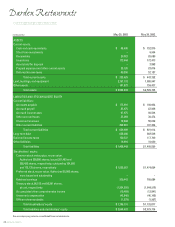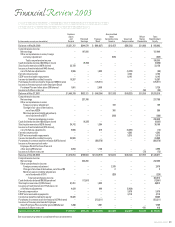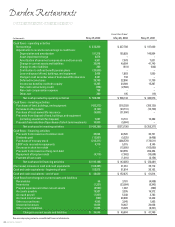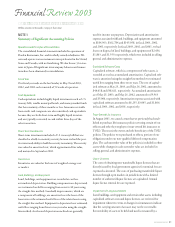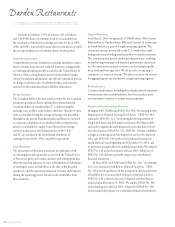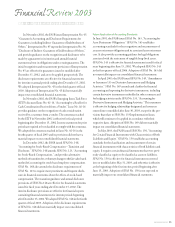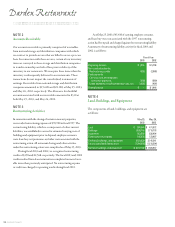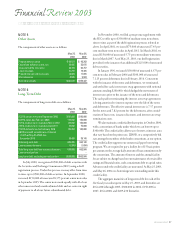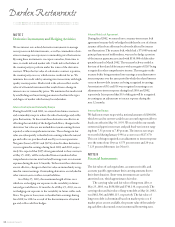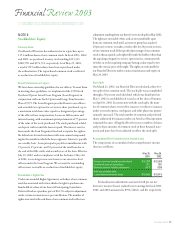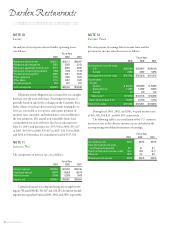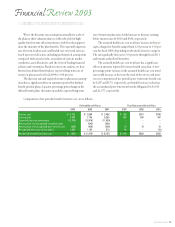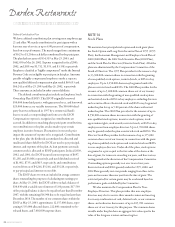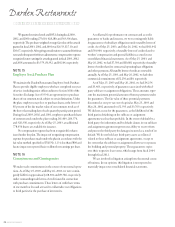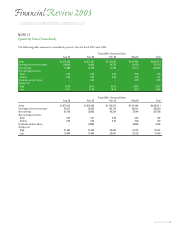Red Lobster 2003 Annual Report Download - page 40
Download and view the complete annual report
Please find page 40 of the 2003 Red Lobster annual report below. You can navigate through the pages in the report by either clicking on the pages listed below, or by using the keyword search tool below to find specific information within the annual report.
38 DARDEN RESTAURANTS
NOTE 7
Derivative Instruments and Hedging Activities
We use interest rate-related derivative instruments to manage
our exposure on debt instruments, as well as commodities deriv-
atives to manage our exposure to commodity price fluctuations.
By using these instruments, we expose ourselves, from time to
time, to credit risk and market risk. Credit risk is the failure of
the counterparty to perform under the terms of the derivative
contract. When the fair value of a derivative contract is positive,
the counterparty owes us, which creates credit risk for us. We
minimize this credit risk by entering into transactions with high-
quality counterparties. Market risk is the adverse effect on the
value of a financial instrument that results from a change in
interest rates or commodity prices. We minimize this market risk
by establishing and monitoring parameters that limit the types
and degree of market risk that may be undertaken.
Futures Contracts and Commodity Swaps
During fiscal 2003 and 2002, we entered into futures contracts
and commodity swaps to reduce the risk of natural gas and coffee
price fluctuations. To the extent these derivatives are effective in
offsetting the variability of the hedged cash flows, changes in the
derivatives’ fair value are not included in current earnings but are
reported as other comprehensive income. These changes in fair
value are subsequently reclassified into earnings when the natural
gas and coffee are purchased and used by us in our operations.
Net gains (losses) of $941 and ($276) related to these derivatives
were recognized in earnings during fiscal 2003 and 2002, respec-
tively. It is expected that $495 of net gains related to these contracts
at May 25, 2003, will be reclassified from accumulated other
comprehensive income into food and beverage costs or restaurant
expenses during the next 12 months. To the extent these derivatives
are not effective, changes in their fair value are immediately recog-
nized in current earnings. Outstanding derivatives are included in
other current assets or other current liabilities.
As of May 25, 2003, the maximum length of time over
which we are hedging our exposure to the variability in future
natural gas cash flows is 12 months. As of May 25, 2003, we are
not hedging our exposure to the variability in future coffee cash
flows. No gains or losses were reclassified into earnings during
fiscal 2003 or 2002 as a result of the discontinuance of natural
gas and coffee cash flow hedges.
Interest Rate Lock Agreement
During fiscal 2002, we entered into a treasury interest rate lock
agreement (treasury lock) to hedge the risk that the cost of a future
issuance of fixed-rate debt may be adversely affected by interest
rate fluctuations. The treasury lock, which had a $75,000 notional
principal amount of indebtedness, was used to hedge a portion
of the interest payments associated with $150,000 of debt subse-
quently issued in March 2002. The treasury lock was settled at
the time of the related debt issuance with a net gain of $267 being
recognized in other comprehensive income. The net gain on the
treasury lock is being amortized into earnings as an adjustment to
interest expense over the same period in which the related interest
costs on the new debt issuance are being recognized in earnings.
Amortization of $53 and $14 was recognized in earnings as an
adjustment to interest expense during fiscal 2003 and 2002,
respectively. It is expected that $53 of this gain will be recognized
in earnings as an adjustment to interest expense during the
next 12 months.
Interest Rate Swaps
We had interest rate swaps with a notional amount of $200,000,
which we used to convert variable rates on our long-term debt to
fixed rates effective May 30, 1995. We received the one-month
commercial paper interest rate and paid fixed-rate interest rang-
ing from 7.51 percent to 7.89 percent. The interest rate swaps
were settled during January 1996 at a cost to us of $27,670.
This cost is being recognized as an adjustment to interest expense
over the term of our 10-year, 6.375 percent notes and 20-year,
7.125 percent debentures (see Note 6).
NOTE 8
Financial Instruments
The fair values of cash equivalents, accounts receivable, and
accounts payable approximate their carrying amounts due to
their short duration. Short-term investments are carried at
amortized cost, which approximates fair value.
The carrying value and fair value of long-term debt at
May 25, 2003, was $658,086 and $740,130, respectively. The
carrying value and fair value of long-term debt at May 26, 2002,
was $662,506 and $680,115, respectively. The fair value of
long-term debt is determined based on market prices or, if
market prices are not available, the present value of the underly-
ing cash flows discounted at our incremental borrowing rates.
Darden Restaurants
Notes to Consolidated Financial Statements


